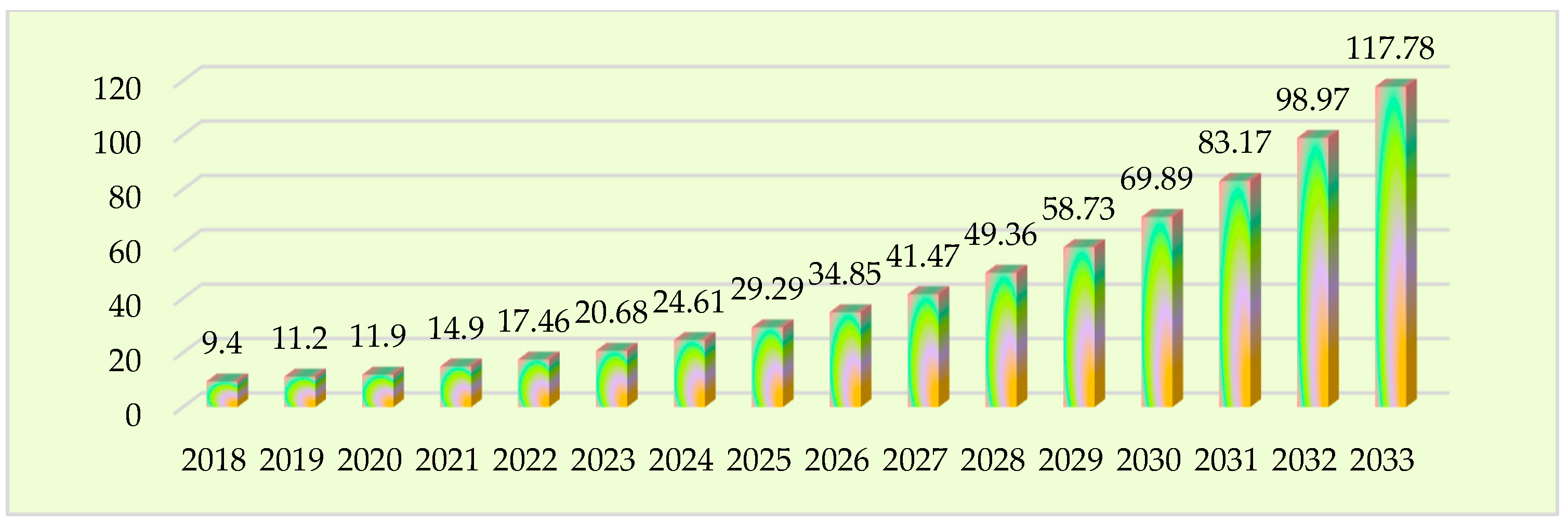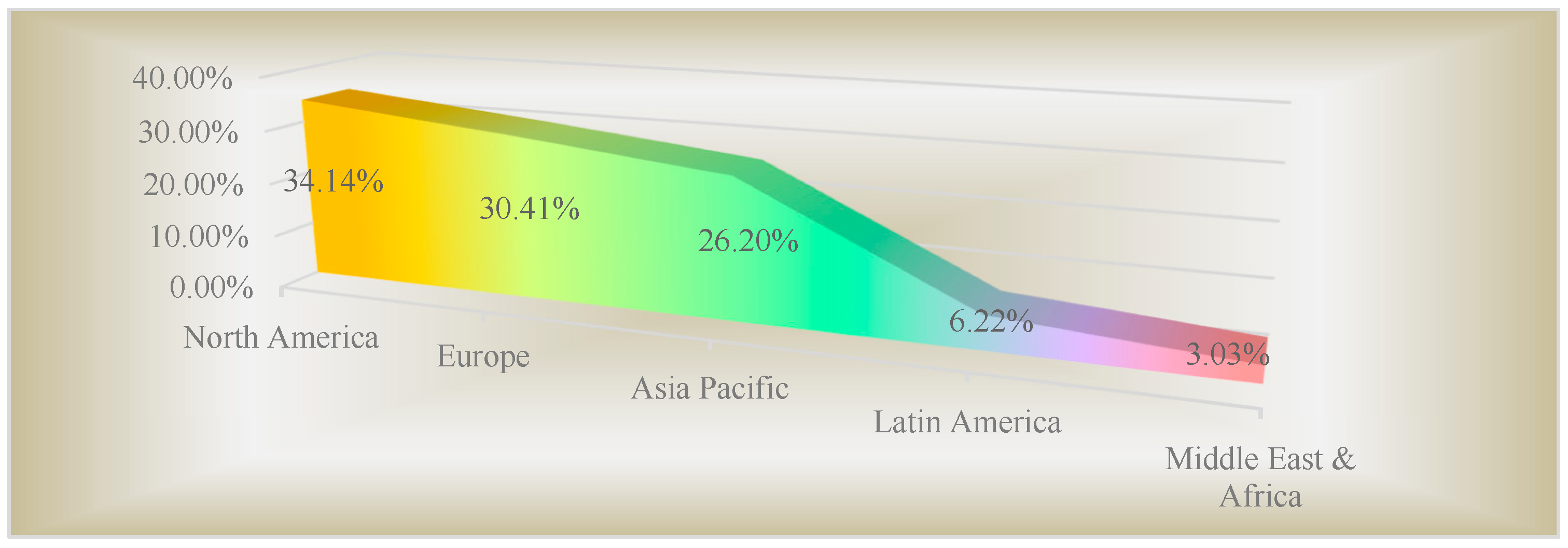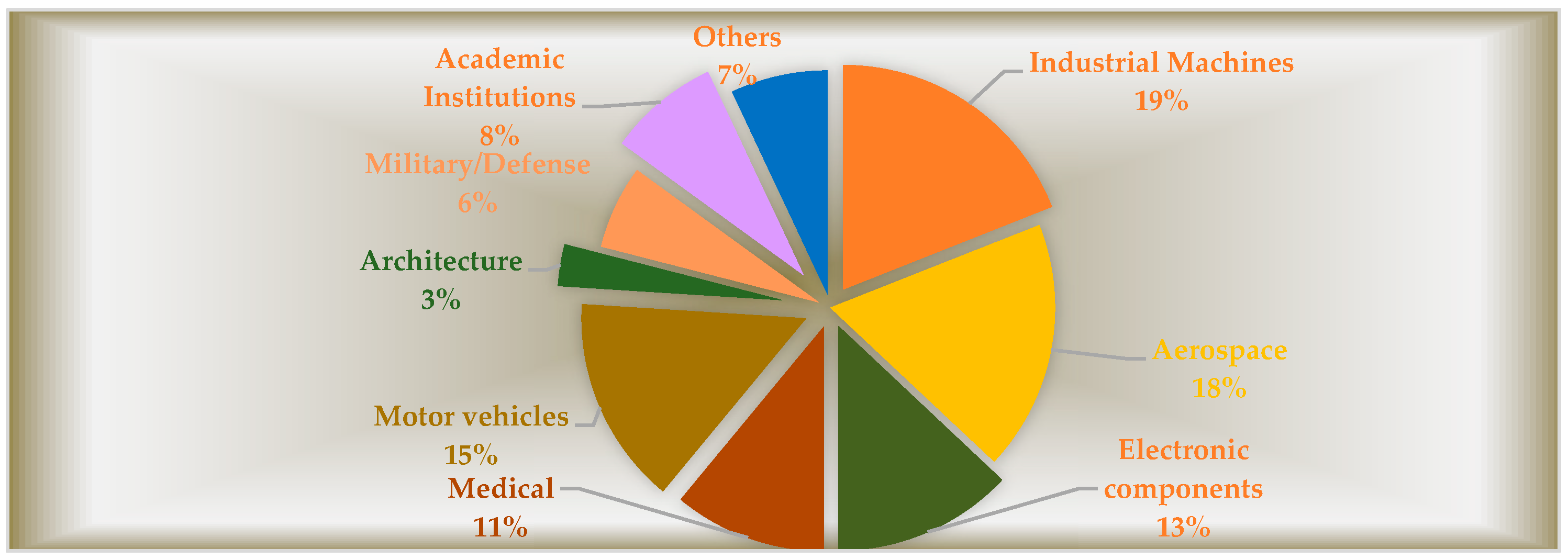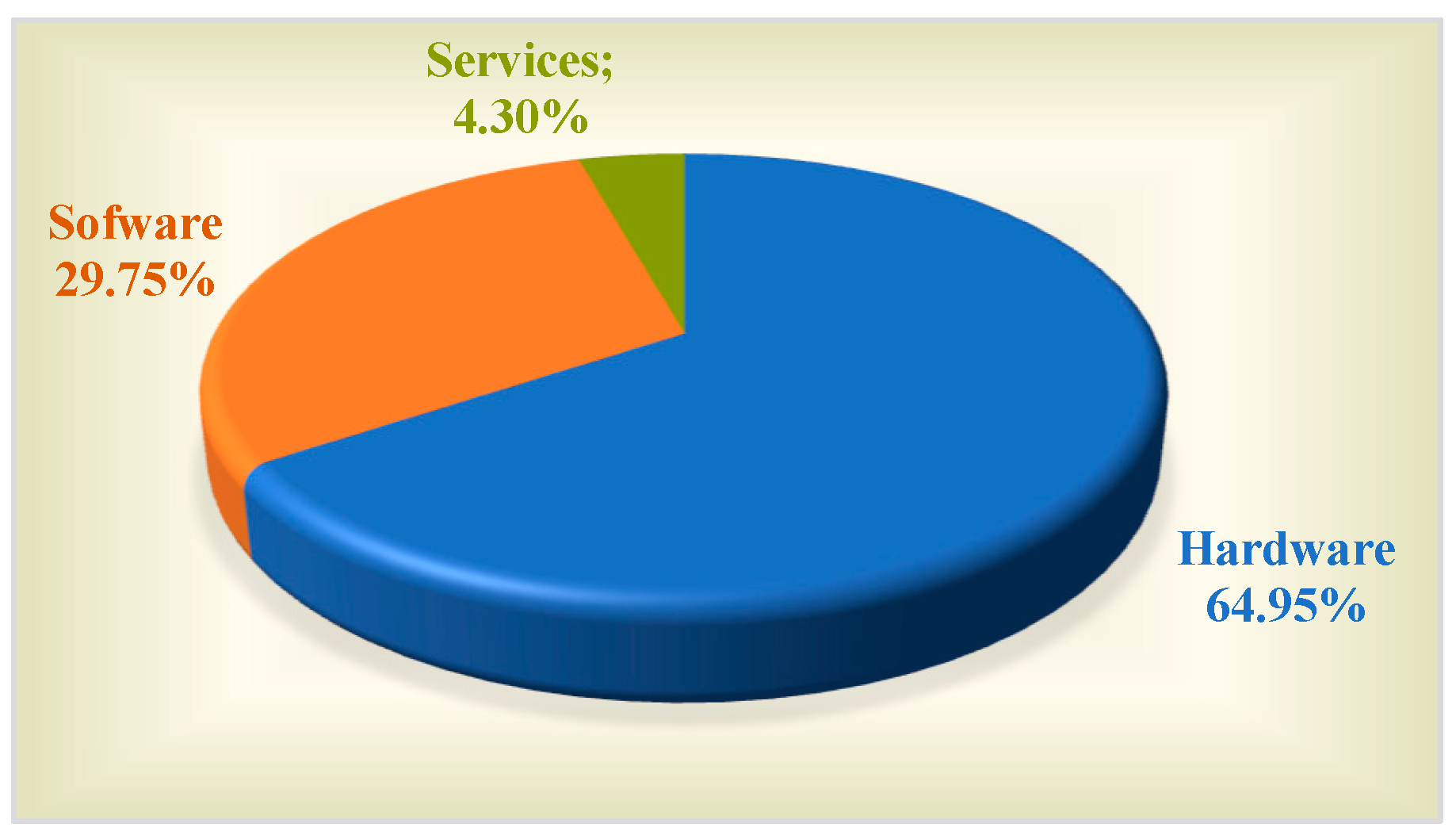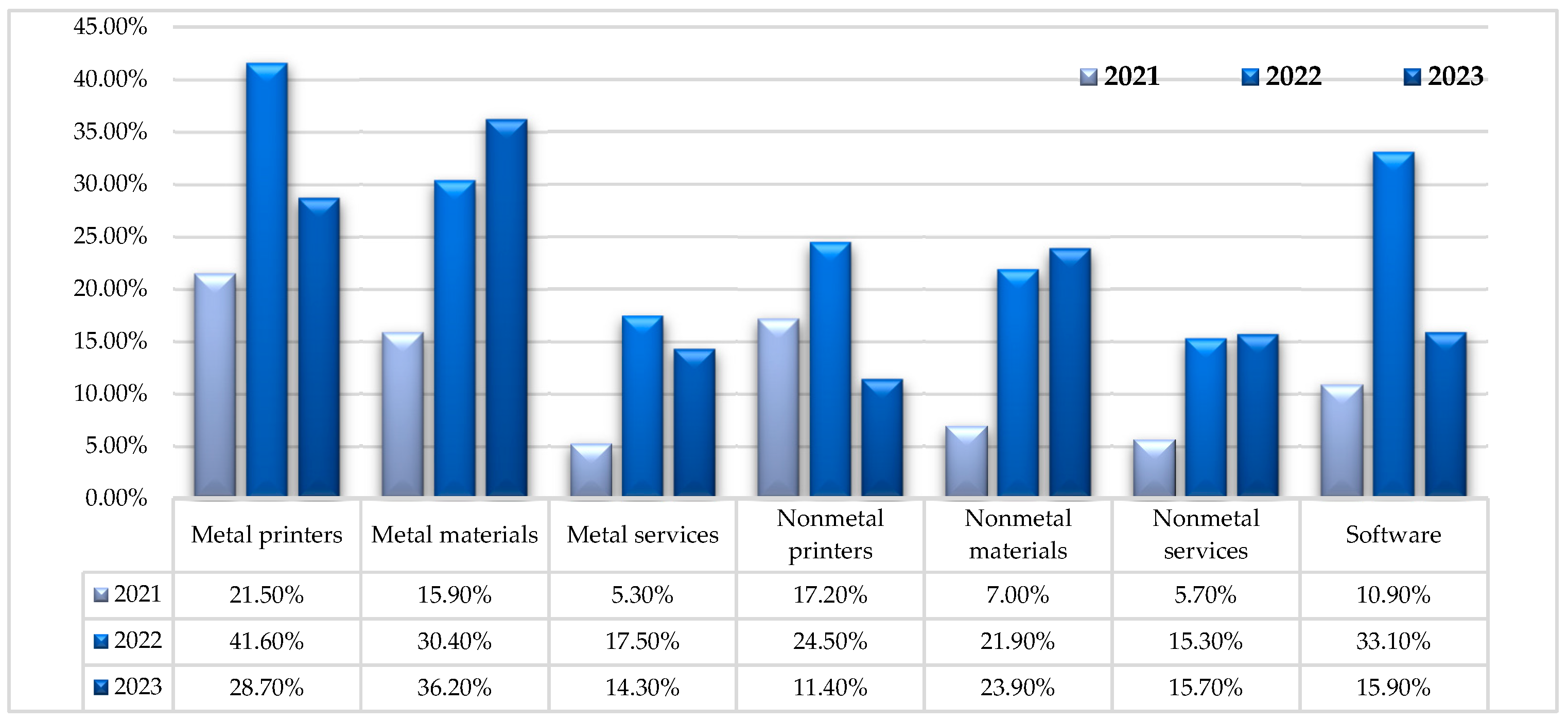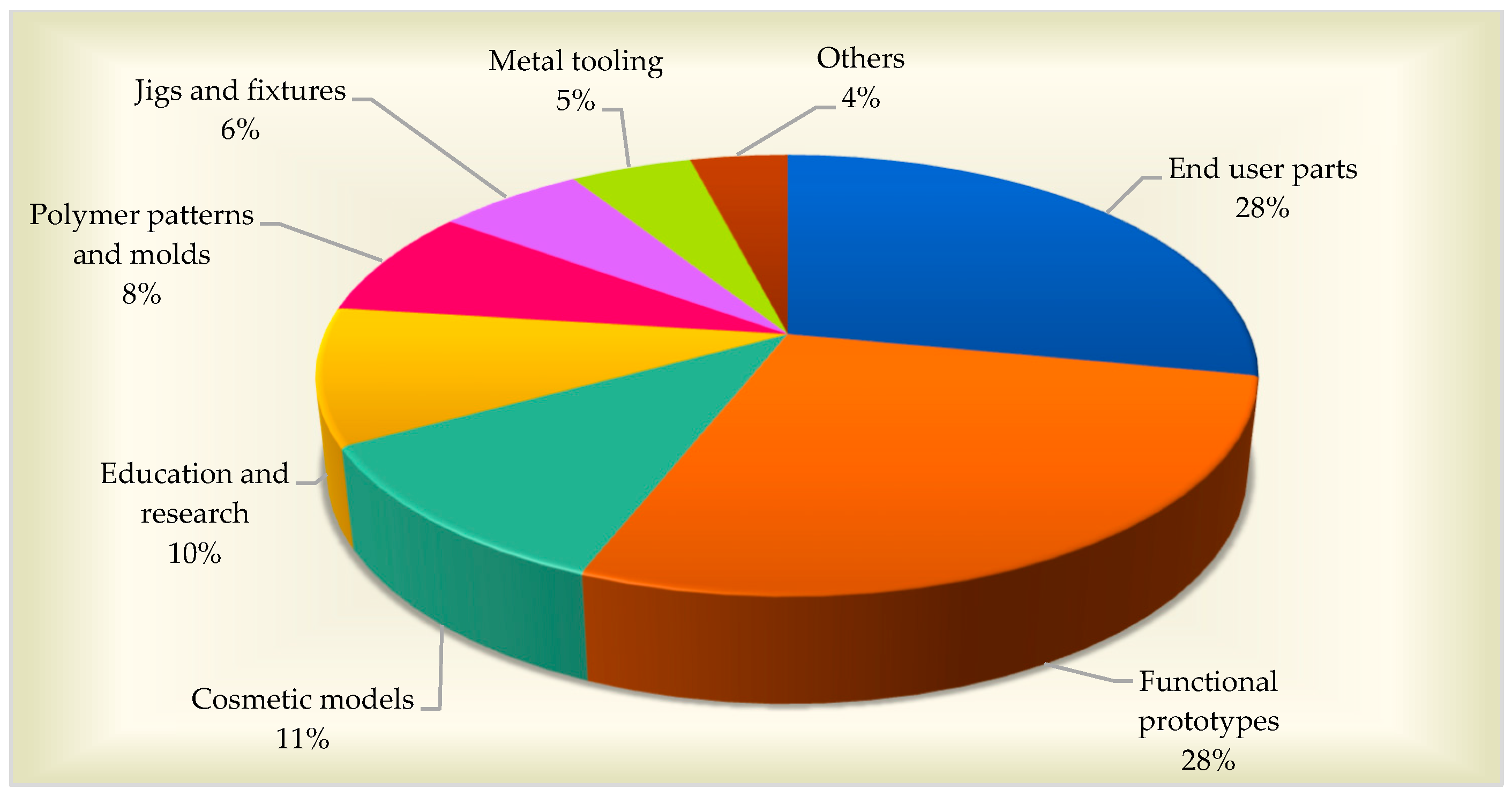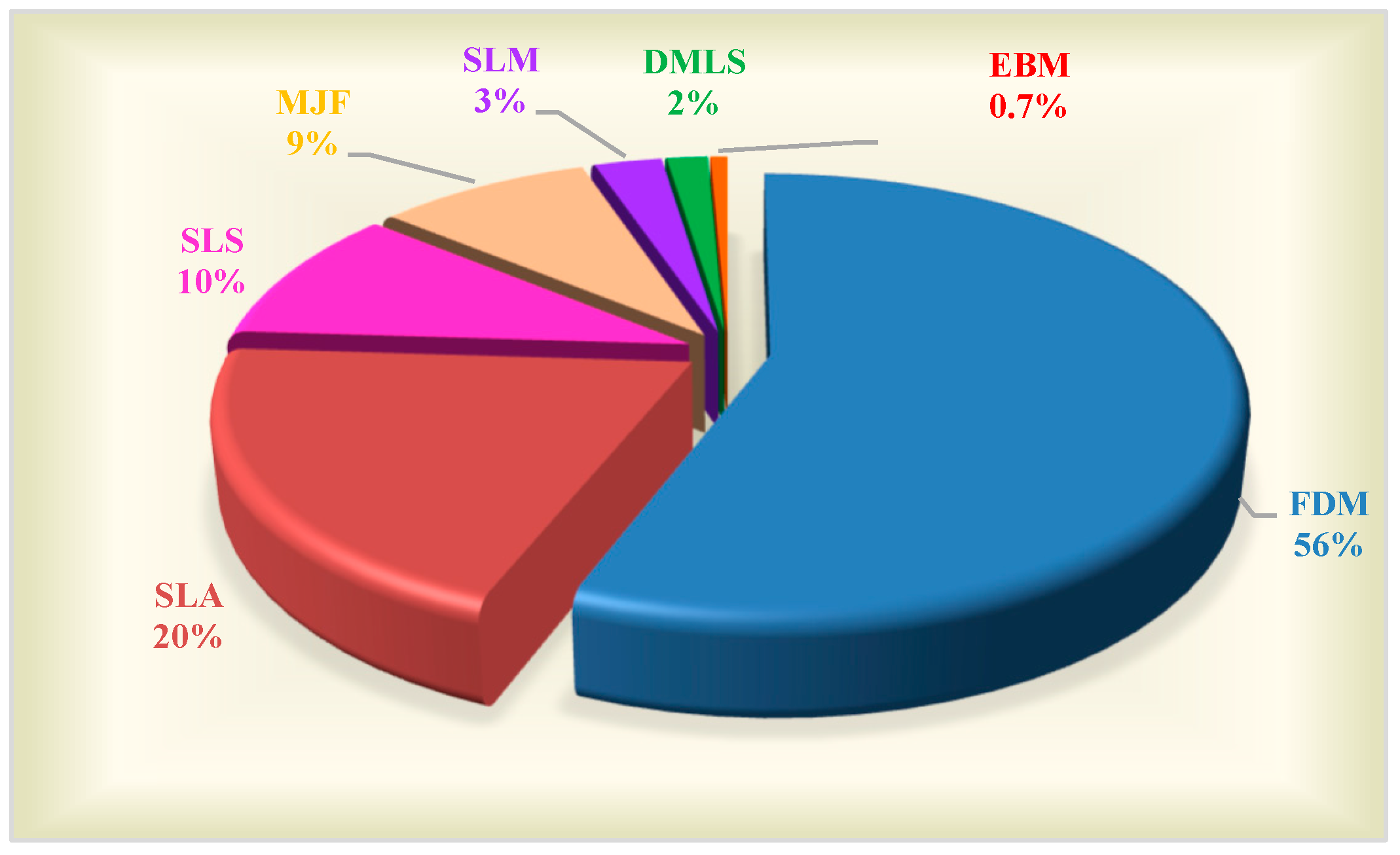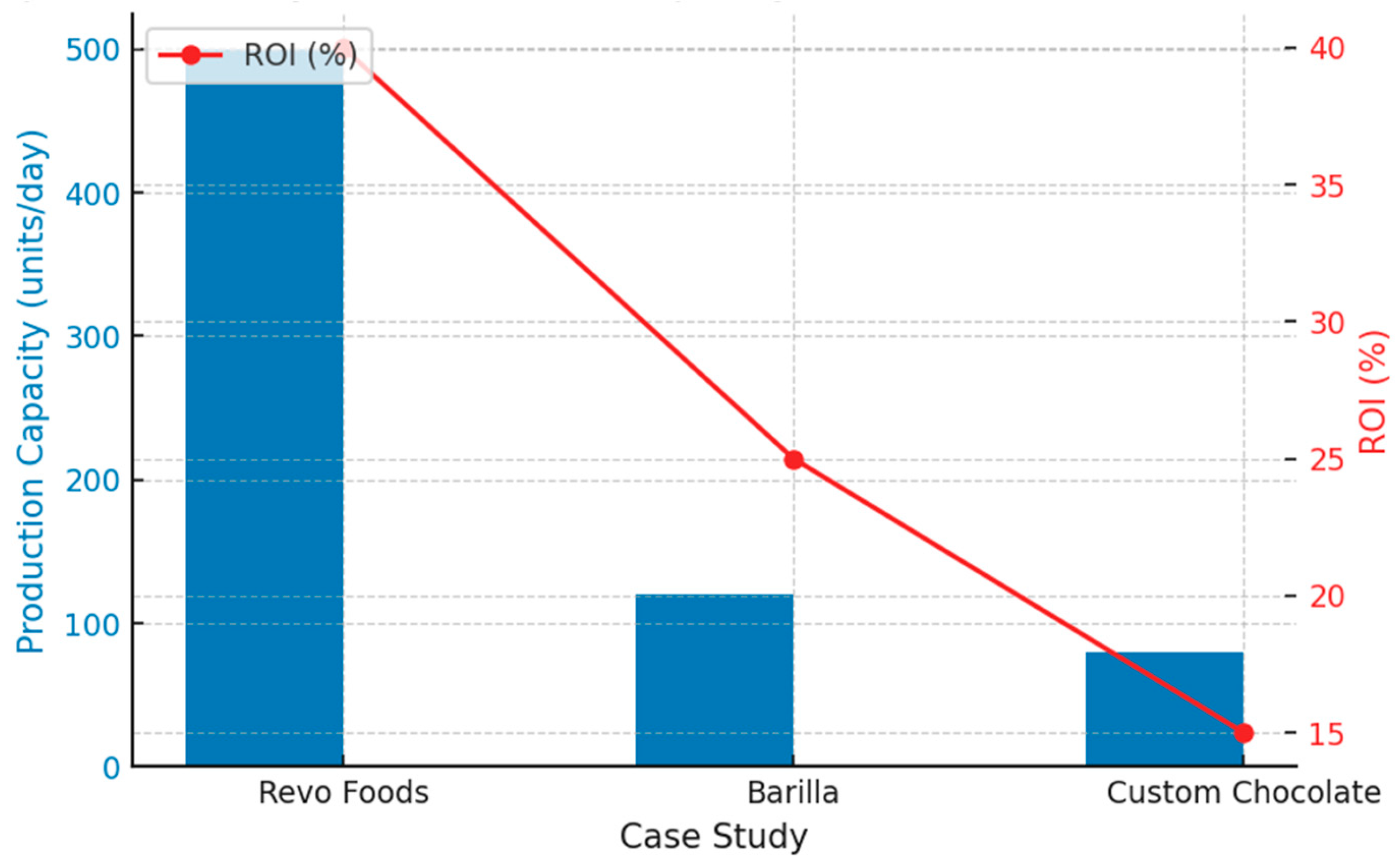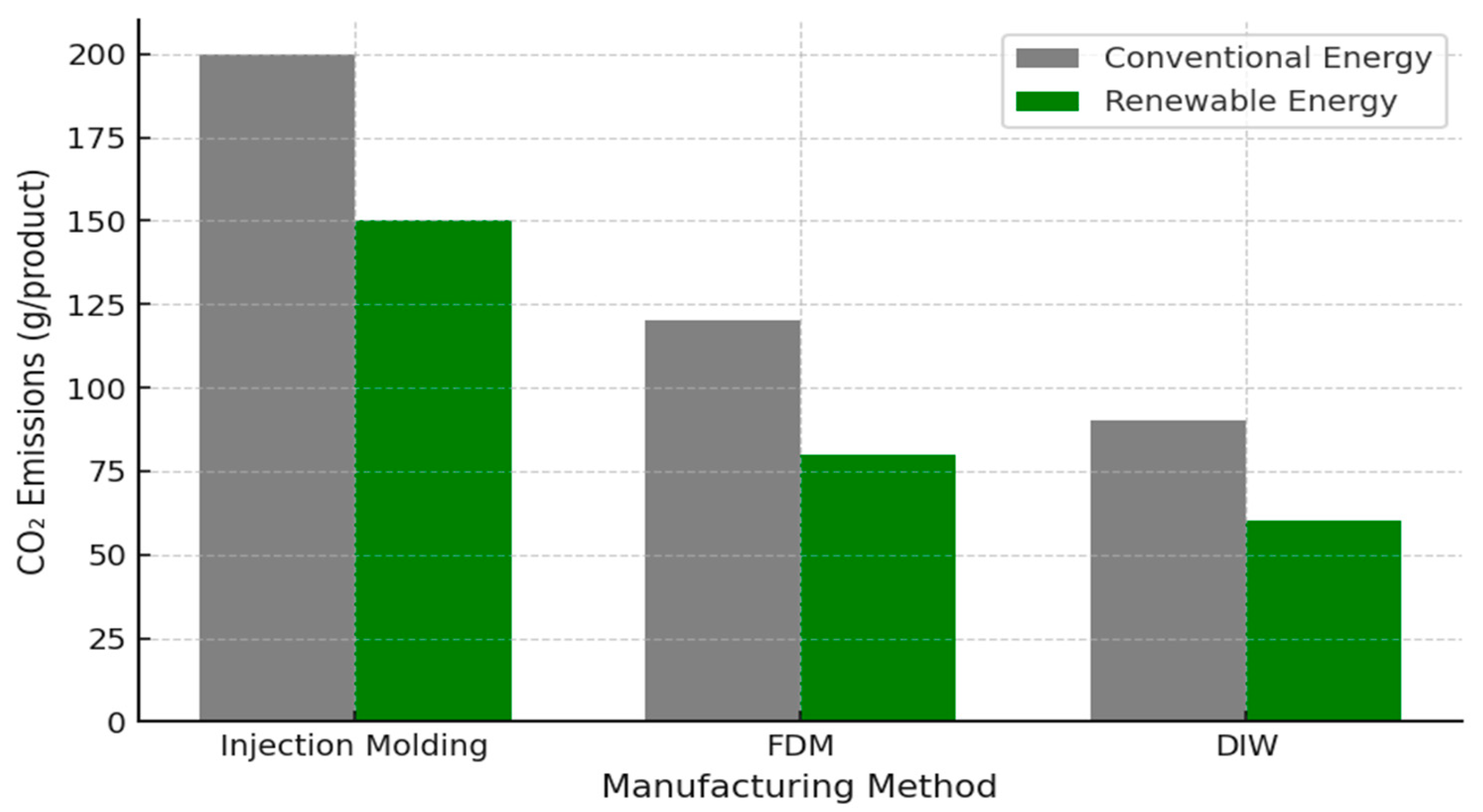1. Introduction
Additive manufacturing (AM), also known as professional or industrial 3D printing, is a relatively new manufacturing method with an extremely wide range of applications and significant advantages for industrial enterprises in various sectors of the economy [
1]. Three-dimensional printing is defined as an advanced digital manufacturing process in which a physical product is created based on a previously prepared CAD (computer-aided design) file [
2]. This process uses a computer-integrated system for layer-by-layer construction of structural objects [
3], starting with a digital model and ending with a three-dimensional object with a predefined geometric shape [
4,
5]. The duration of the production cycle varies from several hours to several days, depending on the complexity of the part.
Over the past decade, additive manufacturing, and in particular 3D printing, has begun to play a key role in the transformation of production processes in the food industry. Three-dimensional printing technologies are successfully integrated into various stages of the food value chain: from customized packaging solutions and automation of production lines to the direct creation of innovative food products with specific functional characteristics.
Through additive manufacturing, food manufacturers can now create packaging with built-in functions to extend shelf life, such as sensors for monitoring temperature or humidity. The technology also allows for a significant reduction in material waste, as it uses exactly the right amount of material, avoiding overproduction and waste typical of conventional methods [
6]. Furthermore, 3D printing offers a high degree of manufacturing flexibility, which allows for the production of small series of products with optimized costs, particularly useful for the production of niche or innovative foods.
Additionally, within the framework of food process automation, 3D printing is used to create specialized tools and components adapted to specific production needs—for example, customized cutting shapes or specific textures in products [
7]. The technology also allows for prototyping of new production lines, which significantly reduces the time and costs of development and implementation.
In the field of personalized food products, 3D printing offers the opportunity to develop foods adapted to individual dietary requirements and preferences. Studies have shown that this technology can be used to create products with added nutritional value, such as vitamins, minerals, or protein enrichment in products such as chocolate desserts and pastes [
8,
9]. Furthermore, 3D printing can create new geometric shapes of foods that are impossible to achieve using conventional methods, with the potential to optimize texture and nutritional profile, for example, foods with a lower fat content or a personalized texture for people with dysphagia.
From an environmental perspective, additive manufacturing significantly contributes to reducing waste in the food industry. While traditional manufacturing methods result in excess materials, often generating thousands of tons of unutilized raw materials, 3D printing uses resources with high efficiency, in full compliance with the principles of the circular economy [
10,
11]. In addition, new research shows how residual products from the fruit and vegetable industry can be transformed into raw materials for 3D printing, promoting sustainable resource utilization.
Despite the progress in the development of 3D food printing, the current scientific literature remains fragmented, lacking integrated studies that systematically integrate the technological, economic, and environmental aspects of the process, supported by empirical case studies and quantitative models for engineering evaluation.
The aim of the present study is to fill this gap by developing an integrated engineering framework for the evaluation of additive manufacturing in the food industry, which combines technological analysis, economic efficiency, and environmental sustainability through quantitative methodology and analysis of real industrial applications.
2. Additive Manufacturing Market Analysis
The additive manufacturing industry has seen significant growth in recent years (
Figure 1). Research suggests that this trend is expected to continue. The global 3D printing market size for 2023 is estimated at USD 20.68 billion [
12]. It is projected to reach USD 24.61 billion by 2024 and exceed USD 117.78 billion by 2033. This growth rate indicates that the market will expand at a CAGR of 19% between 2024 and 2033.
The market distribution by geographical region for 2023 shows (
Figure 2) that North America holds the largest market share—34.14% [
12]. This is due to the USA and Canada, which are among the earliest and leading implementers of these innovations in various production processes. Europe ranks second with a 30.41% market share in the sector. The Asia–Pacific region ranks third with a share of 26.20%, followed by Latin America (6.22%), and Middle East and Africa (3.03%).
Figure 3 presents the data on the application of printed products in various sectors of the economy in 2023. The data indicate a wide diffusion of innovations in this sector [
13].
Studies show that interest in 3D technology has been steadily growing in recent years. The countries that made the largest investments in these technologies in 2023 are presented in
Figure 4 [
14]. Among investors in 3D printers, in 2023, the United States ranks first with a total investment of USD 160.3 million. The United Kingdom is in second place with USD 145.5 million. Germany is in third place with 123.8 million USD, followed by France with USD 115.7 million and China with USD 114.2 million.
The global 3D printer market is divided into three segments—software, hardware, and services. The distribution of revenues by individual segments for 2023 is presented in
Figure 5 [
15]. The data show that the largest share of revenues is generated in the hardware segment, with nearly 65%. The software segment generates 29.75% of revenue, and services have a market share of 4.3%.
The data show that the largest share of revenues is generated in the hardware segment, with nearly 65%. The software segment generates 29.75% of revenue, and services have a market share of 4.3%. The dynamics of market revenues in the period 2021–2023 by additive manufacturing technologies is presented in
Figure 6 [
14].
Stable revenue growth is observed in metal materials, nonmetal materials, and nonmetal service segments, and application data for 3D printers show that they are used mostly for the production of functional prototypes and parts for end users (
Figure 7) [
16].
The total share of the two largest groups—end-use parts and functional prototypes—is 56%. In third place is the application of 3D printers in the creation of cosmetic models (11%), followed by the educational and research sector with 10%, and polymer models and molds with 8%. The least-used applications of 3D printing are for the production of jigs and fixtures (6%), metal tools (5%), and others (4%).
Additive manufacturing technologies can be classified as environmentally friendly manufacturing technologies because of the following reasons: they only use as much material as is necessary to make the final product; during production, material is not separated and discarded, as in traditional methods; additive manufacturing technologies allow for the optimization of each element of the design, resulting in greater lightness, strength, and durability over time.
3. Literature Review on 3D Food Printing
In recent years, interest in the application of additive manufacturing in the food industry has grown exponentially. Initially used for prototyping and packaging design, additive manufacturing has evolved to the point where it is now finding practical applications in the creation of food products and innovative manufacturing components. In [
17], a comprehensive review of the development of 3D food printing is presented, highlighting the possibility of personalized nutrition and the creation of new textures and shapes of food products. In [
18], the analysis is extended by considering the challenges associated with the composition of food “inks”, including viscosity, stability and printability, which remain critical parameters for achieving optimal quality. In parallel, a study [
19] demonstrated that 3D printing can be effectively used to produce personalized food products for specific groups of consumers, such as people with dysphagia, for whom food texture is crucial. In [
20], the authors also highlights the role of AM technologies in the development of personalized dietary solutions, by integrating functional ingredients directly into the structure of the food product.
From an environmental perspective, reference [
21] analyses how the use of food industry by-products in 3D food printing can contribute to reducing waste and closing resource loops within the circular economy. In addition, reference [
22] highlights the need to conduct a full life cycle assessment (LCA) of 3D food printing processes in order to objectively assess the carbon footprint and environmental impact.
Economic analyses remain limited and fragmented. Most available studies focus mainly on laboratory experiments or pilot projects, without in-depth break-even analysis and return on investment (ROI) assessment. In this context, studies such as reference [
23] identify the need to develop dynamic economic models that take into account both the initial costs and potential revenues of implementing AM technologies on an industrial scale.
The overall picture that the literature review outlines clearly show that despite significant progress, current research remains limited in scope, focusing primarily on the technological potential of additive manufacturing. There is a lack of a systematic approach that simultaneously encompasses engineering, economic, and environmental aspects in the context of the food industry.
It is this gap that the present study fills by proposing an integrated framework for the assessment of additive manufacturing, based on engineering calculations, economic analysis, and environmental assessment, supported by real case studies from the industry.
4. Methodology of Engineering Economic and Environmental Assessments
This analysis of additive manufacturing in the food industry has been prepared by applying an integrated methodological framework combining the principles of engineering economic assessment (TEA) and life cycle assessment (LCA). For the purposes of the credibility and transparency of the study, all numerical parameters, formulas and calculations are justified on the basis of peer-reviewed scientific literature, industry reports, and data from production practices.
The main parameters for the calculations in this study have been determined based on a systematic review of published scientific studies, industry analyses, technical documentation of manufacturers of equipment and materials for additive manufacturing, as well as catalog data from established companies in the field of food 3D printing.
Regarding the prices of materials for 3D printing in the food industry, a range of 35 to 50 euros per kilogram was used. These values are extracted directly from the product catalogues of leading manufacturers of food 3D printing equipment and consumables, including Procusini [
24] and byFlow [
25].
An average range of 0.30 to 0.45 kWh per hour was used to estimate the energy consumption of 3D printers in the food sector. These values are based on the technical specifications of food printers listed in the catalogues of [
24,
25].
The emission factor for electricity was assumed to be 0.231 kg CO
2 per kWh, in line with data published by the European Environment Agency (EEA) [
26], which presents a summary European average estimate of the carbon footprint of electricity production.
Regarding transport emissions, a conservative scenario based on an average transport distance of 500 km was adopted for the purposes of this study. This assessment is used for illustrative purposes to ensure baseline comparability within the analysis, taking into account the specific context of localized production in the food industry.
4.1. Formulas Used and Calculation Approach
The quantitative assessment methodology follows established engineering principles for mass–energy and environmental balance. The main calculations include the following:
Power—nominal printer power (kWh/h);
Time—time for producing a single product (h).
- 2.
Carbon footprint assessment:
EF—emission factor of electricity (kg CO2/kWh).
- 3.
Material waste assessment:
Wtraditional—percentage of waste in traditional production;
W
additive—percentage of waste in additive production.
Ctools—costs for tooling in traditional manufacturing;
Ctraditional and Cadditive—costs per unit product in traditional and additive manufacturing, respectively.
4.2. Justification of Assumptions and Limitations
The analysis conducted in this study is averaged and focused on typical production conditions typical of small- and medium-sized batches in the food industry. Several key assumptions were made in developing the methodology to achieve a realistic and applicable framework for the study. First, the use of standard industrial materials for food use was assumed, without the inclusion of exotic or hard-to-find ingredients that could significantly change the results. In addition, the calculations assume an average level of load on the production equipment, without considering extreme operating modes that could affect productivity, energy efficiency, and reliability of technological processes. The analysis also considers a localized production scenario, in which logistics emissions are minimized due to the proximity of the production site to the point of consumption. Additionally, the approach adopted in the study is conservative and does not include additional optimizations such as recycling of residual material or use of renewable energy sources, which means that the actual environmental and economic benefits may be even higher when including these factors in future studies. It is also important to note that all values presented in the article are comparable to the ranges available in the scientific literature and are fully consistent with established good engineering practices for assessing the environmental and economic profile of production technologies. The presented limitations and assumptions should be taken into account when interpreting and applying the results of the study, as they determine the limits of validity and the scope of the conclusions and recommendations made.
5. Materials and Technologies in Additive Manufacturing for the Food Industry
The development of additive manufacturing in the food industry is inextricably linked to advances in materials science and technological integration. To be used safely and effectively in the food sector, materials must meet several regulatory requirements and possess specific properties, including biocompatibility, high-temperature resistance, and food contact. Materials used for 3D printing in the food industry are as follows:
Polylactic acid (PLA). PLA is one of the most commonly used polymers in the food industry due to its biocompatibility and safety for food contact [
27]. Obtained from renewable sources such as corn starch or sugarcane, PLA offers good mechanical strength and stiffness, making it ideal for the production of packaging and prototypes of appliances for the food industry. However, limited thermal resistance remains a challenge, especially in applications requiring high-temperature resistance.
Polyethylene terephthalate glycol (PETG). PETG is recognized as a material with high chemical resistance, flexibility, and transparency, which finds application in the production of robust packaging and equipment components used in the food industry. PETG demonstrates excellent resistance to temperature fluctuations, making it suitable for products subjected to heat treatment.
Nylon (polyamide). Nylon is preferred for the production of highly reliable components in the food industry, thanks to its wear resistance and high mechanical strength. However, not all types of nylon are certified for food contact, which requires careful verification of compliance with standards.
Composite and functional materials. Current research encourages the development of composite materials for 3D printing, enriched with nanocellulose or biodegradable additives, in order to improve mechanical properties and reduce the environmental footprint [
11]. These materials comply with the principles of the circular economy, allowing for the recycling and composting of waste.
The technologies applied for additive manufacturing in the food industry are as follows:
Fused Deposition Modeling (FDM). FDM is the most widely used 3D printing technology in the food industry. It is particularly effective in the production of functional food handling tools, customized packaging, and small-batch production equipment. Advantages include low cost, a wide range of compatible materials, and relative ease of use. Disadvantages include lower precision compared to SLA and SLS technologies.
Stereolithography (SLA). SLA offers high precision and a smooth surface of the manufactured parts, making it a preferred choice for creating molds and matrices for food products. It requires the use of photopolymer resins with certified food safety.
Selective Laser Sintering (SLS). SLS is particularly suitable for the production of functional parts for food machinery that require high durability and resistance to physical stress [
28]. The advantage is that no support structures are required, which simplifies post-processing.
Direct Ink Writing (DIW). DIW is a key technology for the direct printing of food products. It allows the use of pasty materials such as chocolate, dough, fruit, and vegetable purees [
29]. This technology is already being used experimentally to create personalized food products with added nutritional value and controlled texture.
FDM (Fused Deposition Modeling) is a technology that builds objects layer-by-layer from the bottom up, by heating and extruding plastic fibers from an extruder.
SLA (Stereolithography). Stereolithography is an additive manufacturing technology known as bath photopolymerization. It is also known as resin 3D printing. It uses a light source—a laser or projector—to harden a liquid resin and convert it into a solid plastic. In this 3D printing method, a powerful laser is used to harden the liquid resin, creating a desired 3D shape. In the process, the photosensitive liquid is converted into a 3D solid plastic layer-by-layer using a low-power laser and photopolymerization.
SLS (Selective Laser Sintering) is an additive manufacturing technology that uses a high-power laser to sinter small particles of polymer powder into a solid structure based on a 3D model.
MJF is a 3D printing technology that uses ultraviolet light to cure a photopolymer material that is sprayed in the form of small droplets. The technology allows for the production of complex and high-quality fine elements, making it suitable for a variety of prototypes and models, but with limited durability.
SLM (Selective Laser Melting). In this technology, the laser melts the metal powder layer-by-layer until the model is complete. At the molecular level, the powder is melted until a homogeneous mixture is obtained. This process mainly uses pure materials, such as titanium, stainless steel, cobalt, and aluminum, and very rarely alloys.
DMLS (Direct Metal Laser Sintering) is an industrial 3D printing technology that allows the creation of 3D printed metal parts directly from a computer model. The main raw material is metal alloy powder.
EBM (Electron Beam Melting) is a 3D printing technology that uses a high-energy beam of electrons to melt metal powder, instead of a laser. The electron beam produces a stream of electrons directed by a magnetic field, melting layer-upon-layer of powdered metal to create an object that matches the exact specifications defined by a CAD model. EBM is similar to SLM, but instead of a laser, it uses an electron beam.
In summary, the application of additive manufacturing in the food industry encompasses a diverse set of technologies—from Fused Deposition Modeling (FDM) for functional tools and packaging, through Stereolithography (SLA) for high-precision molds, to Direct Ink Writing (DIW) for customized edible products. Each method offers unique advantages and material compatibilities. Nevertheless, global market trends confirm that FDM continues to dominate the field, primarily due to its low operational cost, accessibility, and broad material compatibility. According to recent analyses, FDM accounts for approximately 56% of all 3D printing applications worldwide, followed by SLA. These distribution trends are visually summarized in
Figure 8 [
13], which presents the global usage share of additive manufacturing technologies as of 2024.
6. Smart Packaging and Integrated Sensor Systems
Integrating sensors into packaging allows for real-time monitoring of food storage conditions. Such packaging, produced through additive manufacturing, can include RFID tags and chemical indicators that signal changes in temperature, humidity, or product degradation [
30]. According to studies published in Postharvest Biology and Technology, these innovative packaging processes increase the security of the food chain and allow for better management of product shelf life [
28].
Table 1 presents a comparative overview of the most widely used additive manufacturing technologies in the food sector. The data in it are based on sources [
24,
26,
31].
The productivity of additive processes is a function of print speed, layer thickness and print head travel times. In engineering terms, we can express it as follows:
P—production capacity (cm3/h);
V—lay1er volume (cm3);
S—printing speed (mm/s);
tlayert—printing time per layer (s);
tmove—non-printing movement time (s).
To complement the technological comparison,
Table 2 summarizes the key engineering parameters of selected food-safe materials used in additive manufacturing. The focus is on tensile strength, thermal resistance, viscosity, and biodegradability—all crucial factors for selecting appropriate materials in food applications.
7. Economic Assessment of Additive Manufacturing in the Food Industry
The economic feasibility of implementing additive manufacturing in the food industry is a matter of high engineering and strategic importance. The transition to 3D printing in this sector highlights not only the possibility of production flexibility and customization but also the real financial efficiency at different scales of production.
In today’s dynamic market conditions and growing demand for individualized products, conventional manufacturing processes face serious limitations. They require significant initial investments in tooling, which are amortized only with large production volumes. However, in additive manufacturing, the lack of the need for specialized molds and dies eliminates this cost and makes the technology economically competitive even when producing single or small series of products [
32].
The engineering cost analysis shows that with an average price of FDM filament for food use of approximately 35–50 EUR/kg, and an average packaging weight for an individual food product of around 25 g, the material cost per single product is calculated as follows:
To this, the costs of electricity are added. With an average FDM machine consumption of 0.35 kWh/h and a printing time of one package of about 15 min (0.25 h), the energy consumed is as follows:
With an average price of industrial electricity in the EU of 0.12 EUR/kWh, we obtain the following:
Therefore, the direct production costs per unit of product amount to the following:
In comparison, traditional thermoforming of the same volume of product costs between 0.60 and 0.80 EUR/piece, but under the condition of large series and including significant initial costs for tooling, which amount to an average of EUR 15,000–25,000 [
33].
The calculation of the critical point of profitability n*, which determines the production volume at which additive manufacturing becomes more cost-effective than conventional methods, is based on Equation (4). By substituting the values Ctools = 20,000 EUR, Ctraditional = 0.70 EUR, Cadditive = 1.26 EUR into the cost-balance condition derived from this equation, we obtain n* = −35,714.
The calculated negative value of the critical point of profitability indicates that, under the given cost assumptions, additive manufacturing does not outperform traditional methods in terms of unit cost at any positive production volume. This suggests that, for large-scale standardized production, conventional manufacturing remains economically superior due to its lower per-unit cost.
However, this result does not contradict the strategic advantage of additive manufacturing in specific production contexts. On the contrary, it mathematically confirms its superior cost-efficiency in short-run, highly customized, or design-dynamic applications, scenarios where traditional tooling becomes prohibitively expensive. In conventional manufacturing, each product iteration may require new equipment costing between EUR 2000 and EUR 5000, whereas in additive manufacturing, changes are limited to digital model updates with negligible cost implications [
33,
34].
Moreover, additive manufacturing enables localized and on-demand production, reducing reliance on centralized warehousing and long-distance logistics. This decentralized approach not only cuts operational costs but also reduces the carbon footprint of the supply chain—an environmental advantage that will be discussed in the next section [
35].
The engineering and economic assessment thus demonstrates that additive manufacturing is most cost-effective and strategically justified in scenarios involving the following:
Short-run production (under 1000 units);
High levels of product customization;
Frequent design modifications;
Localized production with rapid delivery.
Therefore, profitability in additive manufacturing should not be evaluated solely based on unit costs, but rather within a broader framework that includes production agility, innovation potential, and sustainability impact. These factors position additive manufacturing as a key enabler of future-oriented and resource-efficient industrial strategies in the food sector.
8. Environmental Assessment of Additive Manufacturing in the Food Industry
The environmental sustainability of additive manufacturing in the food industry is a critical factor for its integration into the global strategy for a circular economy and decarbonization of production chains. The engineering assessment of the ecological footprint should consider not only greenhouse gas emissions during production, but also the entire life cycle of the product, from raw material extraction, through the use phase, to end-of-life and recycling options.
Let us look at the energy profile of additive manufacturing. With an average energy consumption of 0.35 kWh/h for an FDM printer and an average production time of about 0.25 h for a single food package, the electricity consumption per product is as follows:
With an emission factor for electricity in the EU of 0.231 kg CO_2/kWh [
36], we obtain the following:
This corresponds to approximately 20.2 g of CO
2 emissions per unit. In comparison, in traditional injection molding, emissions for a similar item are estimated at an average of 0.032–0.045 kg CO
2 per unit, depending on the complexity of the shape and the efficiency of the process. This range, however, may vary significantly depending on system boundaries, product weight, machine performance, and energy source. The literature reports values from as low as 0.021 kg CO
2 for small, energy-efficient items [
37] to over 0.12 kg CO
2 for heavier or more complex components [
38]. In this study, the estimated emission range corresponds to packaging components with a typical mass of 30–50 g, assuming average EU electricity emission factors.
Thus, with optimized energy management and the integration of renewable sources, additive manufacturing can be comparable to—or even more environmentally favorable than—conventional technologies.
Another important aspect is the reduction in material waste. In traditional manufacturing, the percentage of waste (including overburden, castings, and scrap) reaches an average of 15–20% of the raw materials used, while in additive manufacturing, the material consumption is almost completely optimized, with waste values below 2%. The material waste reduction potential can be assessed through ΔW, as defined in Equation (3), which quantifies the relative difference in material efficiency between additive and conventional production methods:
This substantial waste reduction not only decreases the environmental footprint, but also leads to savings on disposal and recycling costs. Furthermore, the capability of additive manufacturing to utilize biodegradable and recycled materials significantly strengthens its environmental profile. Polylactic acid (PLA), a commonly used material for packaging and food-contact components, is industrially compostable within 90 days—a major improvement over conventional petroleum-based plastics.
Finally, decentralization of production reduces logistics emissions. In traditional models of centralized production and global distribution, the carbon footprint of transportation amounts to approximately 0.07 kg CO2/product, while localized additive manufacturing reduces this value to less than 0.015 kg CO2/product.
In summary, the environmental assessment of additive manufacturing in the food industry demonstrates clear advantages in the following areas:
Reduction in CO2 emissions by up to 40%, especially when integrating renewable energy.
Reduction in material waste by approximately 16% compared to traditional production.
Possibility of using biodegradable and recycled materials.
Significant reduction in the transport carbon footprint through decentralized production.
These results support the conclusion that additive manufacturing can be seen as not only a technologically innovative but also a sustainable choice for the future of the food industry, meeting the global goals of climate neutrality and resource efficiency.
9. Results
The application of additive manufacturing in the food industry is now moving from an experimental phase to real industrial practice, demonstrating tangible economic and environmental benefits. There is an active integration of 3D printing in various subsectors of the food industry—from the development of personalized food products to the production of innovative packaging solutions and automation of production processes.
One of the leading examples of the implementation of additive technologies in a large-scale industrial context is the activities of the Austrian company Revo Foods, which is a pioneer in the creation of 3D-printed seafood of plant origin. The company uses innovative ink formulations based on plant proteins and natural flavors to create fish fillets and salmon that resemble not only the taste qualities but also the texture of traditional seafood. According to data published in Manufacturing Dive, Revo Foods has successfully optimized the production process through additive technologies, achieving not only a reduction in production waste but also a significant reduction in the time for the development of new products [
39,
40].
Another impressive example comes from the research of the Barilla Group, which is implementing 3D printing to create personalized pasta shapes that meet individual consumer preferences. In collaboration with engineering teams and university laboratories, the company is developing additive manufacturing machines that allow customers to design their pasta shapes via web-based platforms. According to a study in Food Engineering Reviews, this not only improves the user experience but also contributes to reducing waste by producing exactly the right amount of product [
41].
In the field of smart packaging, the Dutch company Mimica is demonstrating how integrating sensor indicators into food packaging can provide dynamic shelf-life monitoring. Three-dimensional printing is used to create flexible packaging equipped with sensors that signal deviations in storage conditions or product spoilage. These solutions reduce losses in the supply chain and increase consumer safety. According to a paper in Postharvest Biology and Technology, such smart packaging systems can extend the shelf life of products by up to 30%, which is of great importance for fresh foods and perishable goods [
28].
Alongside these innovative business models, academic institutions are also playing a leading role in promoting additive manufacturing for food applications. University research published in
Processes demonstrates how 3D printing of functional food products with enriched nutritional profiles can address the global challenge of improving food security. This research highlights the importance of integrating biologically active ingredients, such as vitamins, minerals, and probiotics, directly into printed materials, providing personalized nutritional value for different consumer groups [
29].
These examples clearly illustrate that additive manufacturing in the food industry is no longer a hypothetical possibility but a reality with increasing impact. The technology offers a wide range of applications, ranging from improved product sustainability and reduced food waste to providing personalized solutions for end users. With advances in materials science, digital technologies, and automation, the number of companies successfully integrating additive manufacturing into their business models is expected to continue to grow exponentially over the next decade.
Real-world industrial applications of additive manufacturing in the food industry represent a rapidly evolving field that is moving from prototyping to scale-up production. In this section, we present an in-depth engineering analysis of three leading examples, including quantitative data on productivity, energy efficiency, and return on investment (ROI).
Technology: DIW (Direct Ink Writing)
Production capacity: ~200 kg/day
Average printing time per unit of product (≈150 g): 7 min
Energy consumption: ~2.8 kWh/kg of product
Material consumption: ~150 g/item
We calculate the production capacity:
Number of products per day=200 kg/0.15 kg/item=1333 items/day
Energy costs per day:
Energy per day=200 kg × 2.8 kWhkg=560 kWh/day
Return on investment (ROI):
We assume the following:
Average product price: EUR 3.50/unit
Production cost: EUR 1.20/unit
Investment in equipment: EUR 250,000
Annual income: Sannual = 1333 units/day × €3.50 × 300 working days = €1,399,650
Annual costs: Cannual = 1333 units/day × €1.20 × 300 days = €479,880
We calculate the following: ROI = 3.68(or 368%)
Data are based on engineering assessment and technical specifications of the equipment, published on the official website of Revo Foods:
https://www.revo-foods.com (accessed on 3 July 2025).
Conclusion: High return on investment; suitable for scalable production with personalized products.
- 2.
Case Study 2: Barilla—Personalized Pasta with Designer Shapes
Technology: FDM (Fused Deposition Modeling)
Average printing time per portion: 5–7 min
Average material consumption: ~120 g/portion
Energy consumption: ~0.35 kWh/h
Productivity:
Portions per hour = 60/6 = 10 portions/hour
Energy cost: Ehour = 0.35 kWh
Energy cost per portion: Eportion = 0.35/10 = 0.035 kWh/portion
CO2 emissions per portion (at 0.231 kg CO2/kWh):
CO2 = 0.035 × 0.231 = 0.0081kg CO2
Data are based on manufacturing specifications of food equipment using additive manufacturing and an engineering assessment of the technological process.
Conclusion: Suitable for small series, high level of customization, and demonstrations in stores and restaurants.
- 3.
Case Study 3: Custom Chocolate Design—Personalized Chocolate Products
Technology: DIW
Ink Viscosity: 1500–5000 mPa·s
Operating Temperature: 30–34 °C
Printing Time per Product (~100 g): 4–5 min
Production Capacity:
Number of Products per Day = 8 Working Hours × 605 = 96 Pieces/Day
Energy Consumption per Day: Eday = 0.4 kWh/h × 8 h = 3.2 kWh/Day
CO2 Emissions per Day: CO2 = 3.2 kWh × 0.231 kgCO2/kWh = 0.739 kgCO2
Data are based on production specifications of the equipment for chocolate products through additive manufacturing.
Conclusion: Suitable for boutique production and special events with high added value of the products. The engineering analysis of the three case studies shows a clear distinction between industrial-oriented solutions (such as Revo Foods) and boutique or demonstration applications (such as Barilla and Custom Chocolate) (
Table 3).
These differences are visualized in
Figure 9, which presents a comparative analysis of production capacity and return on investment (ROI) for the considered cases.
The analysis demonstrated that, when used at scale with a focus on personalization and sustainable practices, additive manufacturing in the food industry is not only technically feasible but also economically viable. It was also confirmed that additive manufacturing offers flexibility and efficiency, adaptable to different scales and production goals. DIW technology showed significantly higher industrial potential with a capacity of over 1300 units per day, while FDM offers valuable opportunities for niche applications and prototyping. Economic evaluations demonstrated that with proper configuration and optimization of parameters, ROI can reach up to 368%, with Revo Foods’ case demonstrating a combination of high production capacity and significant added value to the product. These results confirm the economic viability of AM technologies for manufacturers aiming for personalized and innovative food solutions.
From an environmental perspective, the life cycle assessment revealed that optimized additive processes lead to a reduction in CO
2 emissions by up to 40% and a waste reduction of approximately 16%, confirming the role of additive manufacturing as a sustainable technology within the circular economy. These results are presented in
Figure 10, which visualizes the comparative carbon footprint of different manufacturing methods and highlights the advantage of additive manufacturing, especially when using renewable energy.
The innovative potential of AM technologies is not limited to the direct production of food products. The integration of smart packaging solutions, customized production tools and the possibility of developing functionalized food “inks” expands the scope of application and opens up new opportunities to improve the efficiency and sustainability of the food industry.
10. Conclusions
This study provides a comprehensive, engineering-based assessment of additive manufacturing (AM) in the food industry, covering the technological, economic, and environmental aspects of its application. Through a multi-level analysis that integrates quantitative data on productivity, energy costs, life cycle assessment (LCA), and techno-economic assessment (TEA), this study offers an integrated perspective on the applicability and sustainability of AM technologies in food production.
From a technological perspective, the results show that FDM (Fused Deposition Modeling) and DIW (Direct Ink Writing) technologies are mature enough for small- and medium-scale production, allowing for the creation of complex geometries and a high degree of product customization. The engineering analysis shows that in applications such as Barilla’s personalized pasta using FDM technology, a throughput of approximately 80 portions per day can be achieved, while in industrial applications of DIW technology, such as Revo Foods, the capacity exceeds 1300 units per day.
Economically, the profitability and return on investment analyses confirm the high competitiveness of additive manufacturing in short-run and customized production conditions. Especially in industrial applications, such as the Revo Foods’ example, a return on investment of up to 368% is reported, which highlights the economic feasibility of integrating AM technologies in the food industry, especially for products with high added value.
From an environmental perspective, the assessment confirms the significant sustainable advantages of additive manufacturing. With optimized operating parameters and the integration of renewable energy sources, carbon dioxide emissions can be reduced by up to 40% and material waste by approximately 16% compared to conventional manufacturing technologies. Furthermore, the possibility of localized production leads to a significant reduction in the logistical carbon footprint.
The integration of smart materials and functional additives, such as freshness sensors, further expands the possibilities of additive manufacturing in the food industry and responds to the growing demand for highly customizable and sustainable products.
This study makes a significant contribution to the scientific and engineering community by establishing a structured and reproducible methodological framework for evaluating additive manufacturing in the food sector. By combining theoretical models, empirical data, and practical case studies, the article provides not only an analytical tool for researchers but also a practical guide for industrial practitioners and strategic decision-makers.
Based on the analyses performed, several priority directions for future scientific and engineering research in the field of additive manufacturing for the food industry are highlighted.
First of all, a thorough experimental study of the influence of printing parameters on the environmental properties of the materials used and the quality of the final product is needed. Particular attention should be paid to the development of new, functionalized food “inks” with improved texture, nutritional value, and stability during printing.
In addition, the integration of sensor technologies into products and packaging, together with 3D printing, provides an opportunity to create intelligent solutions for traceability and food quality assurance throughout the supply chain. Research in this direction will facilitate the transition to fully digitalized and adaptive production systems.
From an environmental perspective, future analyses should consider the impact of large-scale integration of renewable energy sources on the carbon footprint of additive manufacturing, as well as the possibilities for implementing circular production models by recycling and reusing residual materials.
Finally, there is a need to develop dynamic economic models that include not only the initial investment and operating costs, but also the potential revenues from the implementation of personalized solutions and new business models based on on-demand manufacturing.
The indicated directions outline a sustainable scientific and applied perspective for building on current results and accelerating the integration of additive technologies in the food industry in the context of Industry 4.0 and the circular economy.
